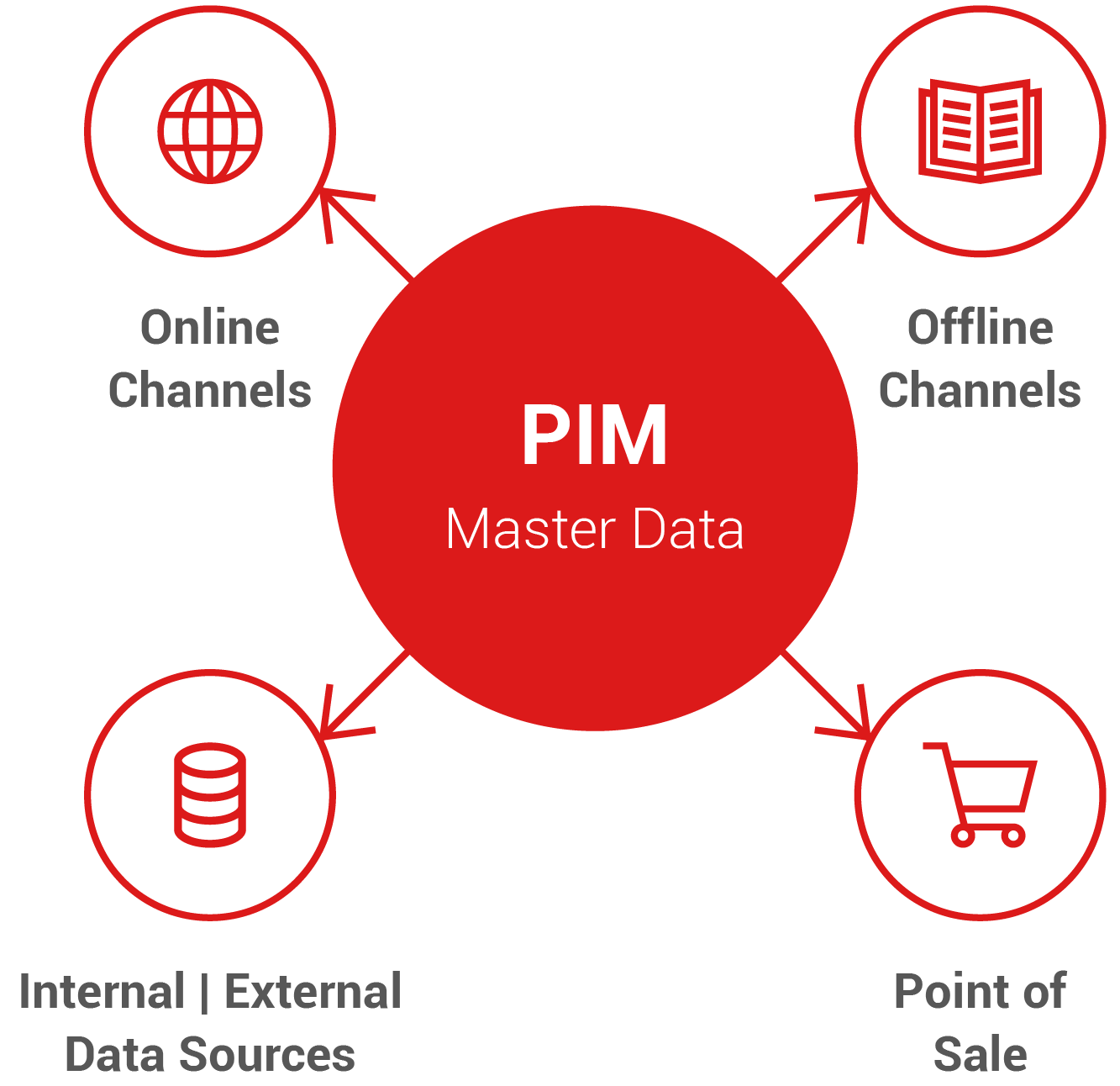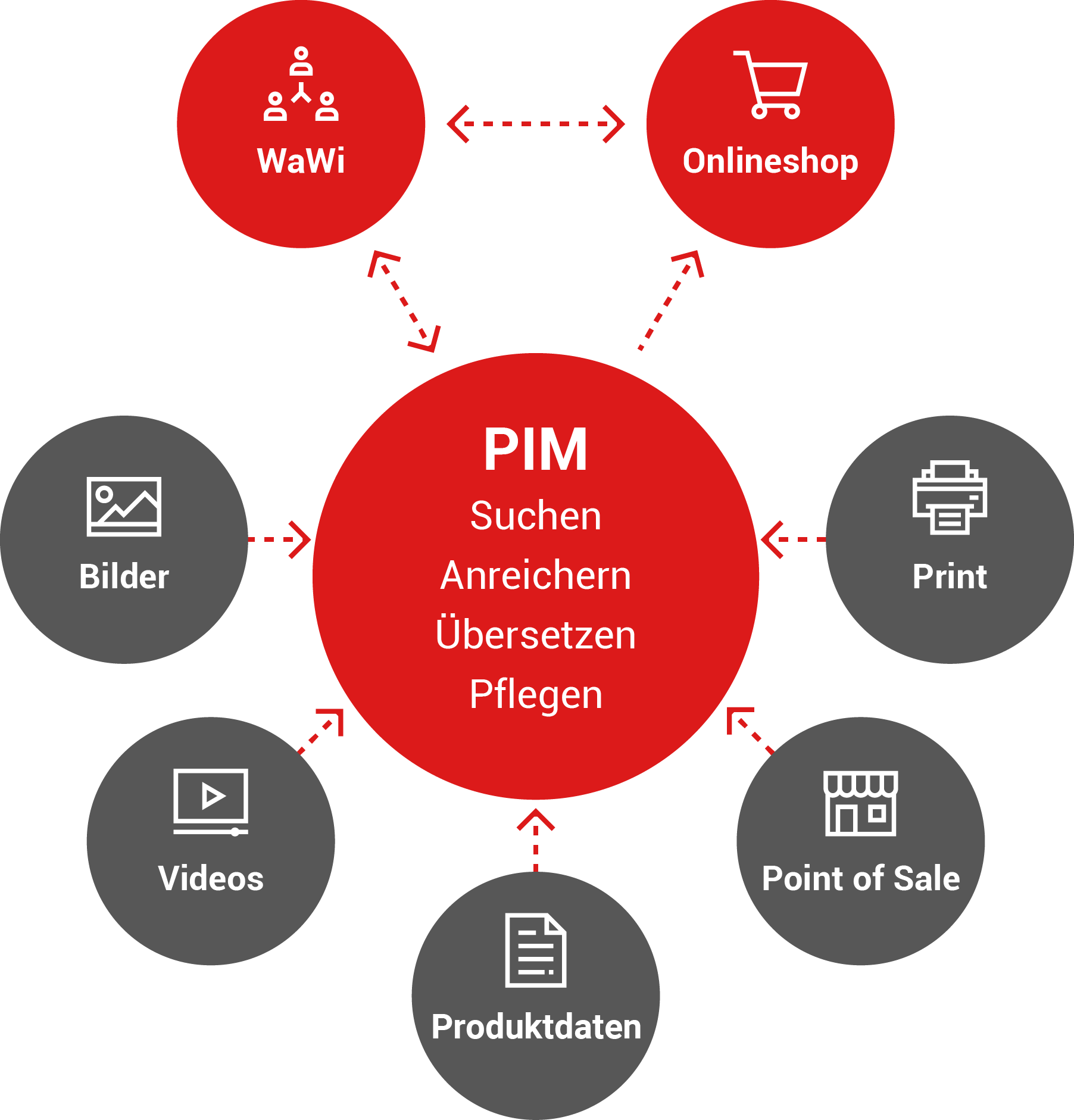
Table of Contents
What is PIM?
It is not always easy to decode the acronyms which are used in relation to product data and its management. What does the term PIM actually mean?
In general, a PIM system, unabbreviated, means a product information management system which allows to manage the catalog and product information centrally and make this data available for different channels.
 PIMs were created already in the early 90s, when the Internet became more and more important in everyday life. Businesses needed a central repository for product data.
PIMs were created already in the early 90s, when the Internet became more and more important in everyday life. Businesses needed a central repository for product data.
With the help of a PIM system, all information, which is related to the offered products, is collected, standardized, improved, supplemented, translated (if necessary) and finally published via all necessary channels. The term “PIM” is thus often used in the meaning of a PIM system, an instrument for implementing efficient product information management in a company.
The extensive information about a product is the purpose of any PIM system - it includes all product-related data such as descriptions, marketing texts, texts for landing pages, product features, technical specifications, images, videos, and other documents and media files.
Thanks to a product information management system, you can get a lot of benefits, including:
- significantly improve the data quality;
- reduce time and costs while preparing the product data;
- provide well-structured product information faster;
- organize better cooperation during the preparation of the product information;
- keep the data up-to-date via various channels;
- manage all product data in a central repository.

PIM and Online Shops
 Digitally recorded product data is very suitable for e-commerce because the detailed, qualitative, and well-structured product information can reach an online shop much faster than any other sales channel. A PIM system can be used in order to automatically transfer new products, product descriptions and media data to an online shop as well as modify or supplement existing product information.
Digitally recorded product data is very suitable for e-commerce because the detailed, qualitative, and well-structured product information can reach an online shop much faster than any other sales channel. A PIM system can be used in order to automatically transfer new products, product descriptions and media data to an online shop as well as modify or supplement existing product information.
A PIM helps to create a high-quality, well-structured and detailed product description that allows customers to make a right purchase decision. Such product information provides an excellent way to show the product to the customer at its best. The deployment of a PIM also reduces the return rate - more detailed and qualitative product data reduce the possibility that a customer will be not fully satisfied with a purchase.
A product information management system executes all tasks related to the preparation of product descriptions and ensures that they are transferred effortlessly and completely to your online shop with the aim of increasing your conversion rate and thus your sales.
PIM and WMS
Currently, many distributors and producers still use an WMS system (unabbreviated: a Warehouse Management System) or Excel to manage their own product data. An WMS manages the resources available in a company - especially capital, staff, and production means - and controls almost all areas of a company and their processes, including manufacturing and selling products. In this case, the completeness of the product information is totally neglected, because a warehouse management is primarily specialized in the organizations of the activities which are related to the products themselves (production, storage, sale, shipping, returns processing, etc.), but not their description, not to mention that the quality of these descriptions are supposed to be checked and several staff members of a company or even external specialists (e.g. photographers) must be consulted.
No warehouse management system is good enough to support the process of preparing the product data because it was created for entirely different purposes. This is where a PIM system comes into play.
A PIM system, unlike an WMS, takes a closer look into product information, processes it, and makes it efficient for multichannel marketing and distribution. A PIM is a centralized repository for all product information of a producer or wholesaler which can be used for many channels at the same time, taking into account their specific features - whether it is a print catalog, website, online shop, WMS software or any third-party system from a partner.
A PIM is a valuable addition to WMS, because a warehouse management system is supposed to be used not for product communication, but sales processing. All functions that deal with the preparation of the qualitative and marketing-relevant product information, are taken over by a PIM. A warehouse management system ensures an efficient sales process, while a PIM system ensures that your products are even purchased. Furthermore, a PIM system supports you in preparing all necessary information for international sale – in case there are other units of measurement or languages. For internationally oriented shops this information is supposed to be adapted. If this is done automatically, it saves a lot of time. A product information management system was created to manage product data, and it offers many features, which an WMS system does not have.
PIM, WMSs and Online Shops In Practice
For many producers, wholesalers and online retailers it is typical to use a WMS together with an online shop. In this article, we would like to show you how to apply a PIM system efficiently. Depending on the specific requirements of a company, the cooperation between WMS, PIM and one or more online shops can be organized in different ways. The following usage scenarios are the most typical and recommended for practical usage.
Usage Scenario 1
In the first usage scenario, both WMS and PIM are connected with two online shops via a connector. The information about the availability and product stocks is sent directly from the WMS to the shops. New products are also created in the WMS. All product information, product features, product images and cross-selling products are transferred to the online shops from the PIM system. If it is necessary, you can also write individual product descriptions for each online shop, because an online shop is treated as a separate channel. Thus, each system can serve its own purpose - the online shop ensures the sale and acceptance of new orders, the WMS system guarantees the processing of orders and PIM provides the right promotional content for your products to be sold.
The advantages of such a construction are –
- Clear separation of features between the systems.
- Clear division of roles and user management - those internal and external staff members, involved in content marketing and the preparation of texts, product images, and other product information, do not necessarily need access to the warehouse management system.
- High flexibility and confidence in the future, because each system can be replaced at any time by another system.
- A web-based PIM offers much higher flexibility for all users, because “web-based” means accessible from anywhere”, what often leads to faster results.
For the existing connector between your warehouse management system and your online shop, there would also be a necessity for a connector between your online shop and the selected PIM system. AtroPIM, for example, offers connectors for all popular shop systems such as OXID, Magento or Shopware. In order to associate a WMS and PIM with product information and ensure efficient product mapping, it may be necessary to have a simple connector between these WMS and PIM.
Usage Scenario 2
In this usage scenario, no full-featured connector of PIM to both shops is required, since all data from PIM gets into the shops through WMS. For this reason, it is necessary all data to be stored completely in the WMS. A clear advantage of this usage scenario is that fewer connectors are needed to ensure data exchange. The big disadvantage, however, is that such a solution is rather impractical and even impossible for all warehouse management systems.
This usage scenario requires the existing connector between your WMS and your online shop to be greatly expanded, and new fields have to be created in the WMS itself and possibly other adjustments have to be made there. This often leads to the situation, when the implementation of the usage scenario 1 is simply cheaper, faster, and easier. But it can be completely different. The cost estimate and evaluation of the usage scenario, which is the best for you, should be made for each user individually.
In general, a user should make a decision on their own, taking into account the specific features and requirements of their new construction.
Conclusion
In spite of different opinions, a PIM is neither a superfluous nor expensive system to use.
In fact, there are free open source PIM systems like AtroPIM or Akeneo. Even though there will be implementation costs, they will be more than just fully covered since you will save time and money while preparing the product information and benefit from increasing your conversion rate and sales. An efficient PIM system is an essential addition to your warehouse management solution and online shop today, as it arranges your product data and the way it is communicated, helping the visitors of your online shop to make the right purchase decision faster. A PIM offers even more: as a multichannel system, it allows you to provide not only your shop, but also the systems of your B2B customers and partners with qualitative data.


